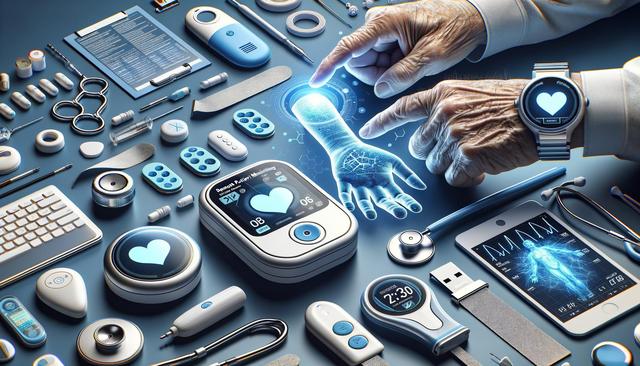
Enhancing Chronic Care with Remote Patient Monitoring Devices
Understanding Remote Patient Monitoring in Chronic Care
Remote patient monitoring (RPM) has become a vital component of modern healthcare, particularly for individuals managing chronic conditions such as hypertension, diabetes, heart failure, or COPD. These devices allow patients to collect health data at home and transmit it securely to their healthcare providers. This continuous exchange of information helps in proactive intervention, reducing emergency visits and hospitalizations. For people with long-term illnesses, consistent monitoring supports better outcomes and improved quality of life. RPM devices are especially effective when designed to integrate seamlessly with digital platforms, allowing both patients and doctors to track trends and make informed decisions.
In chronic care management, RPM devices often measure and relay data such as:
- Blood pressure
- Blood glucose levels
- Weight and BMI
- Oxygen saturation
- Heart rate and ECG data
These metrics are essential for detecting early warning signs and adjusting treatment plans accordingly. With remote monitoring, care becomes not only more accessible but also more tailored to the patient’s ongoing health needs.
FDA-Approved Kits: Ensuring Safety and Reliability
When it comes to medical devices used in chronic care, safety and accuracy are non-negotiable. FDA-approved RPM kits are rigorously tested to meet high standards of performance, usability, and data security. This approval signifies that the device has undergone thorough clinical evaluation and is deemed effective for its intended use. For patients and healthcare providers, FDA approval offers peace of mind and assurance in the device’s capabilities.
FDA-approved RPM kits typically include:
- Bluetooth-enabled measurement devices (e.g., blood pressure cuffs, glucometers)
- Data transmission modules or apps
- Cloud-based dashboards for clinicians
- Secure data encryption to protect patient privacy
These kits are designed to be user-friendly, with clear instructions and intuitive interfaces, making them suitable for elderly patients and those with limited technical experience. The integration of approved components also facilitates accurate diagnostics and timely medical interventions.
Bluetooth Sync: Real-Time Data Sharing Made Simple
Bluetooth synchronization plays a central role in the efficiency of remote patient monitoring. Devices with built-in Bluetooth capabilities can automatically connect to smartphones or tablets, transmitting data in real time to healthcare systems. This process eliminates the need for manual data entry, reducing the risk of errors and enhancing the speed of communication between patients and providers.
Benefits of Bluetooth sync in RPM devices include:
- Immediate data access for healthcare providers
- Automatic logging of vital signs
- Alerts triggered by readings outside safe parameters
- Seamless integration with mobile health apps
Bluetooth-enabled RPM solutions are particularly useful in managing chronic conditions because they ensure that any changes in a patient’s condition are quickly observed. This means that care teams can intervene before minor issues escalate into serious complications.
Access for Doctors: Empowering Providers with Actionable Insights
One of the greatest strengths of remote patient monitoring is the enhanced access it provides to physicians and care teams. RPM platforms offer healthcare professionals a consolidated view of a patient’s ongoing health status. Instead of relying solely on occasional in-person visits, doctors can review data trends and detect abnormalities as they happen. This access translates into more informed decision-making and timely care adjustments.
Some features commonly available to doctors through RPM platforms include:
- Customizable dashboards displaying patient vitals
- Automated alerts for critical readings
- Communication tools for virtual consultations
- Analytic tools to track long-term trends
This level of access helps shift healthcare from reactive to proactive. Doctors can identify patterns in a patient’s condition, adjust medications remotely, and even schedule follow-up appointments based on real-time data rather than pre-set intervals. This responsiveness can lead to better health outcomes and enhanced patient satisfaction.
Benefits for Patients: Convenience, Confidence, and Continuity
For patients managing chronic conditions, remote patient monitoring offers multiple advantages beyond clinical accuracy and real-time communication. The ability to monitor one’s health from home fosters greater engagement and accountability. Patients become active participants in their care, which can be empowering and motivating. Moreover, the convenience of not having to frequently travel for check-ups is especially beneficial for those with mobility limitations or those living in remote areas.
Key benefits for patients include:
- Improved adherence to treatment plans
- Reduced hospital admissions and emergency visits
- Quicker response to health changes
- Greater peace of mind through continuous monitoring
Remote monitoring also supports continuity of care. Even when patients change locations or health providers, their data can travel with them, ensuring that new medical teams have access to complete and up-to-date information. This continuity is vital for chronic care management, where long-term trends often shape treatment strategies.
Conclusion: Supporting Smarter Care from a Distance
Remote patient monitoring devices are reshaping the landscape of chronic care by offering FDA-approved, Bluetooth-synced tools that keep patients and healthcare providers connected. These technologies are not only improving access and accuracy but also fostering a more proactive approach to health management. As more individuals and care teams adopt remote monitoring, the potential for improved outcomes, greater convenience, and reduced healthcare costs continues to grow. For those managing chronic conditions, RPM offers a modern, effective way to stay on top of their health while remaining comfortably at home.


